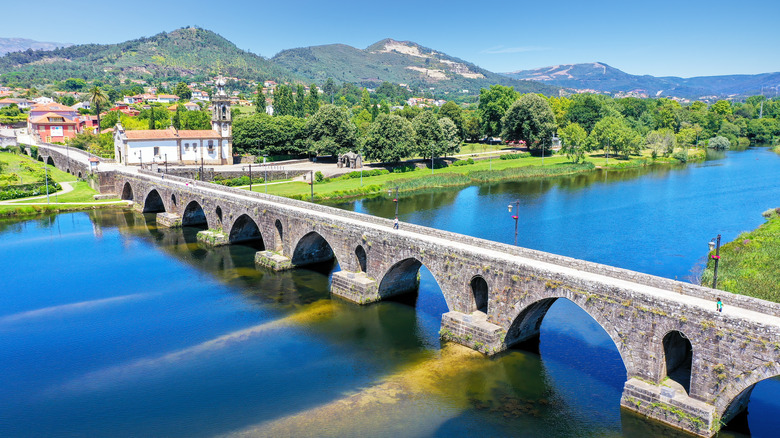Luscious Rolling Hills And Charming Towns Line Portugal's 'Green Wine Route'
There are lots of reasons to visit Portugal. The country has a ton of natural beauty, it's one of the more affordable places to visit in Europe, and it's home to dozens of gorgeous medieval towns. Although it's not totally under-the-radar anymore, it's often overshadowed by other European countries like Spain, France, or Italy, even for foodies and wine lovers.
But if you're looking for a way to discover delicious cuisine and excellent wine, Portugal, especially the Vinho Verde wine route, should certainly be on your travel bucket list. Vinho Verde translates to "green wine" in English, named for its use of comparatively "young" and acidic grapes as well as how green the landscape is in Minho, the primary province where these grapevines are grown. Vinho Verde isn't necessarily green in color, though; in fact, it can refer to both the red and the white varieties of the wine.
This particular region of Portugal has so much to offer in terms of beautiful scenery, fantastic architecture, and excellent wines that are distinctive to this part of the country. Located in northwest Portugal, the region is comprised of nine subregions, including Lima, Basto, Amarante, Tâmega e Sousa, Paiva, Monção e Melgaço, Cávado, Ave, and Baião. If you're trying to decide between going to Porto or Lisbon on your next trip, Porto is definitely the best city to start with if you're interested in the Vinho Verde wine route. Although Porto is just outside all of the aforementioned subregions, it is generally a good place to fly into and then drive around the countryside.
Where to go on the Vinho Verde wine route
Vinho Verde wine is generally affordable, mildly carbonated, and light. Most wines are excellent with seafood and vegetable dishes but can also pair well with meats. They're also fairly low in alcohol. Different subregions also produce different styles of Vinho Verde that will taste and look different from place to place. Some wineries are also hotels, like Monverde, a hotel that is attached to the Quinta da Lixa winery in Amarante or the Torre de Gomariz Wine & Spa Hotel, located just outside of Braga, one of Portugal's oldest cities. Or you can find various hotels (including historic estates that have been converted) or Airbnbs in the main towns that are closest to the wineries you would like to visit on your trip. Check out wine tours that will organize stops for you if you're not sure where to start. Some of these tours are multi-day and may also include meals and accommodation, so its best to research which one is best for you.
There are thousands of wineries in this region to choose from. Some of the most popular wineries that also offer tours and tastings include Quinta De Lourosa in the Tâmega e Sousa subregion, Casa de Vilacetinho in Amarante, Quinta de Santa Cristina in Basto, and Quinta do Ameal in Lima. The oldest winery in the region is Quinta de Pacos in Monção, with other 500 years of operation under its belt, and the largest exporter is Quinta da Aveleda in Tâmega e Sousa. One of the northernmost wineries is Quinta de Soalheiro, which crafts Alvarinho wines in Monção.
Other attractions to explore along the Vinho Verde wine route
While the wineries are arguably the region's biggest draw, there are lots of other things to do in the Vinho Verde region besides the wine. The area is also breathtakingly beautiful and should inspire a need to get into the great outdoors. Peneda-Gerês National Park, the only designated national park in the country, is the perfect place for people who enjoy mountainous hiking and biking, exploring medieval villages, and taking in incredible views of nature. Taking the Geira Roman Road in the part also has historical significance since it is a path leftover from the Roman occupation. This area is also known for its Iberian wolves and wild horses that roam the landscape.
And if you're looking for great restaurants and shopping, you can't go wrong exploring the various small towns in the region. Among the oldest and most picturesque are Braga and Amarante, which both see their fair share of tourists. Other popular towns to visit include Ponte de Lima, the oldest town in the country famous for its cultural festivals, and Viana do Castelo, which is often called the most beautiful town in Portugal. About 30 minutes south of Viana do Castelo is the town of Durrães, where you will find the Avianese chocolate factory (the oldest chocolate company in Portugal). Of course, a few Portuguese chocolates make the perfect dessert to go with your Vinho Verde. While you're sampling the wine, be sure to try some of the local dishes as well, including various stews made with goat and pork, jesuitas (a puff pastry and egg custard dessert), and of course, lots of seafood.


